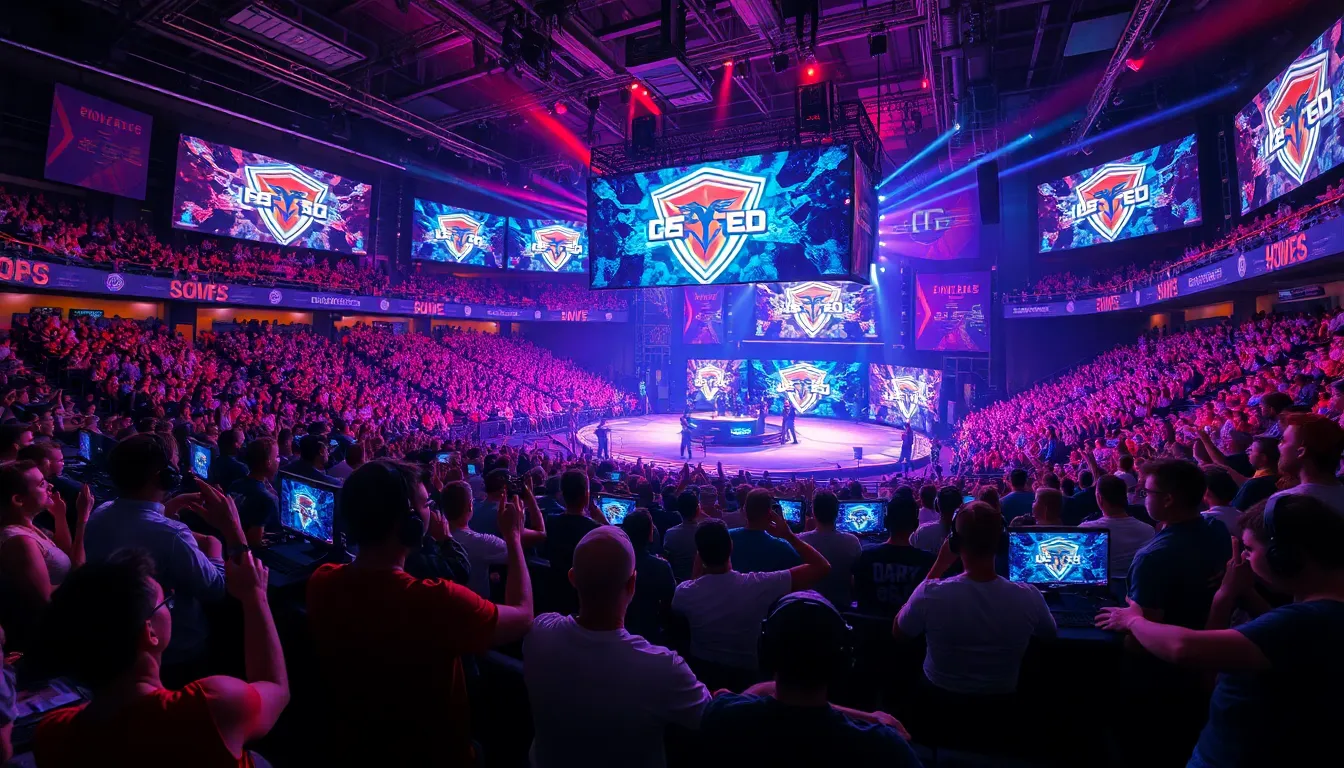In the fast-paced world of gaming, esports organizations have emerged as the rock stars of the digital arena. With flashy logos and dedicated fan bases, these teams are not just about pixels and power-ups; they’re a multi-million dollar industry that’s reshaping the landscape of sports. Imagine a world where your favorite gamers are treated like elite athletes—well, that world is here, and it’s buzzing with excitement.
Table of Contents
ToggleOverview of Esports Organizations
Esports organizations play a pivotal role in the gaming industry, serving as the backbone for competitive teams. These organizations encompass various functions, from team management to brand development. Individual teams often represent specific games like League of Legends or Dota 2, fostering dedicated fan followings.
Revenue generation within these organizations stems from multiple sources. Sponsorships, merchandise sales, and media rights significantly contribute to their financial success. Notably, the global esports market reached approximately $1.08 billion in revenue in 2021 and is predicted to continue growing.
Fostering talent development remains essential for esports organizations. They invest in training facilities, coaching staff, and player welfare programs. Through these initiatives, rising stars receive the support they need to hone their skills.
Fan engagement also ranks as a priority for esports organizations. By utilizing social media and community events, they build strong connections with supporters. Engaged fans not only boost team morale but also enhance overall brand visibility.
Partnerships with streamers and content creators offer additional visibility. Organizations collaborate with popular figures to promote events and products. This approach allows them to tap into established audiences and amplify their reach.
Professional players often become ambassadors for these organizations, further solidifying the connection with fans. Players engage directly with audiences through live streams and social media, drawing attention to their teams. As a result, personal branding intertwines with organizational success, elevating both players and their teams in the competitive landscape.
Overall, esports organizations remain influential players in the evolving digital arena, shaping the future of competitive gaming as they continue to innovate and expand their reach.
Key Players in the Industry

Esports organizations shape competitive gaming, and several major entities lead the charge.
Major Esports Organizations
Organizations like Team Liquid, Fnatic, and TSM dominate the esports landscape. These teams represent various games, securing top performers in titles like Counter-Strike and Fortnite. Sponsorships play a critical role in their financial success. Teams often collaborate with brands, significantly boosting visibility and engagement. Revenue from merchandise sales, advertisements, and media rights elevates their status. Market analysts report that Team Liquid generated over $40 million in revenue in 2021 alone. Engaging fan bases allows these organizations to cement their place in the industry and attract continued investments.
Emerging Brands
New brands frequently enter the esports space, fueling competition and innovation. Organizations like 100 Thieves and G2 Esports illustrate the potential of fresh market players. These teams blend gaming and lifestyle, appealing to a broader audience. Their unique branding strategies leverage social media for organic growth, reaching millions of fans. G2 Esports, for instance, has garnered over 10 million followers on Twitter. Investments in up-and-coming talent enhance their rosters and ensure sustainability. The rise of these emerging brands contributes to the dynamic evolution of the esports industry.
Structure of Esports Organizations
Esports organizations maintain complex structures that support high-level competitive gaming. Various components contribute to their success.
Team Composition
Players represent core components of any esports organization. Typically, a roster consists of five to six players for team-based games like League of Legends and Counter-Strike. Coaching staff provides strategic insight and guidance, often comprising former professional players. Analysts study gameplay patterns and statistics to enhance team performance. Support staff, such as psychologists and nutritionists, help maintain player well-being, ensuring they peak during competitions. Each role contributes to a balanced and effective team dynamic.
Management and Operations
Management oversees critical operations that facilitate success. Executives and team managers handle sponsorships and financial planning, often negotiating multi-million dollar deals. Marketing teams promote brand identity through social media and community engagement, fostering fan loyalty. Event organizers plan participation in tournaments, balancing travel logistics and accommodation for players. Technical staff ensures that gaming setups remain optimal, addressing any hardware or software issues. Operational efficiency drives the organization forward, preparing them for competitive challenges.
Financial Aspects of Esports Organizations
Esports organizations navigate a complex financial landscape driven by various revenue streams and competing challenges. Understanding these dimensions is crucial for their success.
Sponsorship and Revenue Streams
Sponsorships serve as a primary revenue source, accounting for a significant portion of income. Major organizations like Team Liquid earned over $40 million in 2021 from sponsorship deals alone. Merchandise sales also contribute substantially, as fans purchase jerseys and branded items to show support. Media rights, including streaming deals, offer additional income. Advertisers are increasingly interested in the esports audience, leading to lucrative partnerships. The global esports market reached approximately $1.08 billion in revenue in 2021, with anticipated growth, signaling a strong future. This diverse financial base helps organizations thrive in a competitive environment.
Challenges and Opportunities
Esports organizations face notable challenges while also encountering unique opportunities. Managing financial sustainability can be difficult, as many teams invest heavily in player development and facilities. Player retention becomes crucial in a rapidly evolving industry. Rising talent may draw offers from other teams, creating a competitive landscape. However, opportunities arise through expanded viewership and increased mainstream recognition. Engaging fan bases across multiple platforms allows organizations to build dedicated communities. Innovations in gameplay and tournament formats foster fan interest and can lead to new partnerships. Staying adaptable helps organizations leverage emerging trends, securing a stronghold in the market.
The Future of Esports Organizations
Esports organizations are on the brink of significant evolution. They continue to shape the gaming landscape while embracing new opportunities and challenges.
Trends to Watch
Increased investment in talent development is becoming a major trend, as organizations allocate resources toward coaching and player healthcare. Technological advancements also play a role, with virtual reality and augmented reality set to transform gaming experiences. Fan engagement strategies are evolving, leading organizations to leverage interactive content and live events to enhance viewer connection. Sponsorship dynamics shift as brands seek deeper collaborations with clubs, aiming to create integrated marketing campaigns that resonate with audiences. The overlap between gaming and lifestyle brands expands as organizations explore new merchandising opportunities, appealing to a broader demographic of fans.
Predictions for Growth
Experts project continued revenue growth within esports organizations, forecasting a global market value exceeding $1.5 billion by 2023. Sponsorship revenue appears poised for substantial increases, potentially reaching $1 billion annually in the near future. Participation in new esports titles is anticipated, diversifying revenue streams and attracting varied audiences. Streaming platforms play a critical role in this growth, offering new avenues for content consumption and monetization. Competitive gaming is likely to gain more recognition, with potential inclusion in future Olympic events enhancing legitimacy and visibility. With emerging markets showing interest, geographical expansion promises to bring esports to a global audience, further solidifying the industry’s presence.
Esports organizations are redefining the landscape of competitive gaming. Their influence extends beyond just gameplay to encompass branding fan engagement and financial growth. As they continue to innovate and adapt to market demands the potential for further expansion remains significant.
With a focus on talent development and strategic partnerships these organizations are poised to shape the future of esports. The ongoing evolution of technology and fan interaction will only enhance their role in bringing gaming into the mainstream. As the industry grows so too will the opportunities for both players and fans alike.


